Ham croquetas and sauerkraut croquettes
Cooking two fiddly and elaborate fried starches just because you can't make up you mind which you want is more or less canonically indulgent. Nonetheless, that's what I did on Thursday. I'd not made croquetas before, and something about the idea of frying dollops of sauce just didn't seem quite right. Into that uncertainty crept all sorts of thoughts about adding potato which didn't seem quite right either.So it was a bet-hedging exercise. There'd be croquettes if the croquetas didn't work out, and no need to run either by trying to combine both.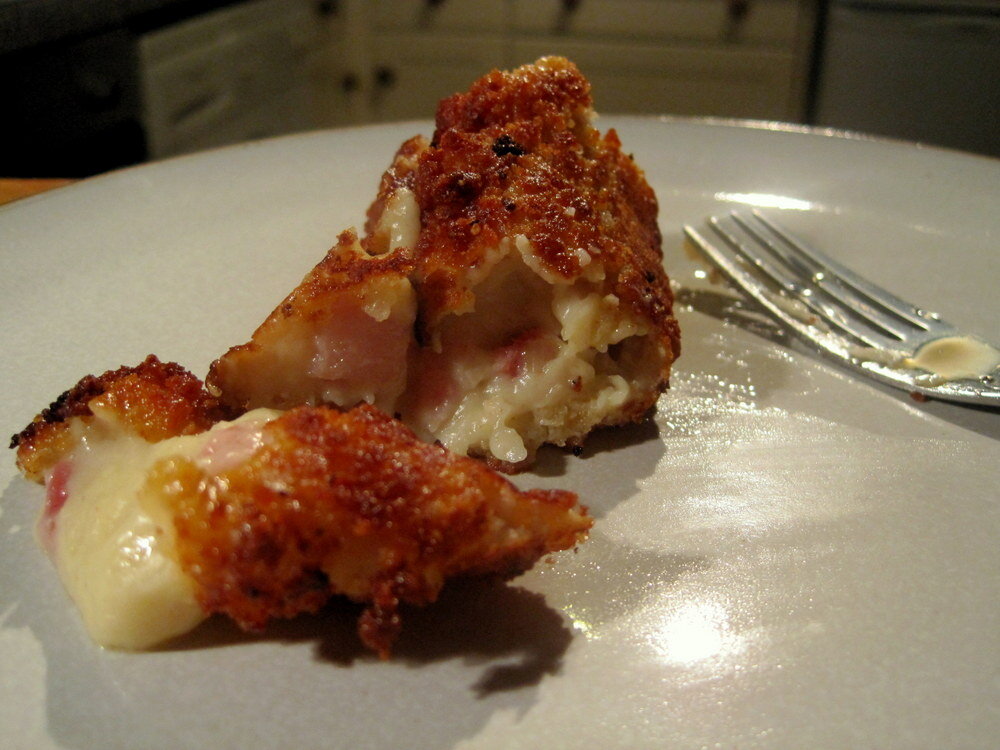 To spoil the ending, it mostly worked. The croquetas suffered from not being deep-fried, an instruction I was foolish to ignore. The croquettes were just a little too doughy, and this again was a simple, fixable, process error.
To spoil the ending, it mostly worked. The croquetas suffered from not being deep-fried, an instruction I was foolish to ignore. The croquettes were just a little too doughy, and this again was a simple, fixable, process error.
What it means to be a croquette
I should probably stop using "croquetas" and "croquettes" as though they're meaningfully differentiated. Croquetas may capture the Spanish version that would be béchamel based, but croquettes itself appears to be an umbrella term, and does not have potatoes as a prerequisite. Indeed, Wikipedia lists eighteen countries with some kind of claim upon the croquette, and under that umbrella huddle fillings ranging from the standard béchamel and potato, to peas and tuna; although mercifully not together.I've not eaten an authentically Spanish example, but I've had good ones in Belgium. There, they can be potato or béchamel, and the ones I had were the latter. However much you know you're just eating a basic white sauce, it doesn't override the richness of the experience. They're smooth and gooey, shouldn't be too heavy, and somehow feel a bit decadent, despite having an ingredients list as dour as a wet afternoon in Halifax.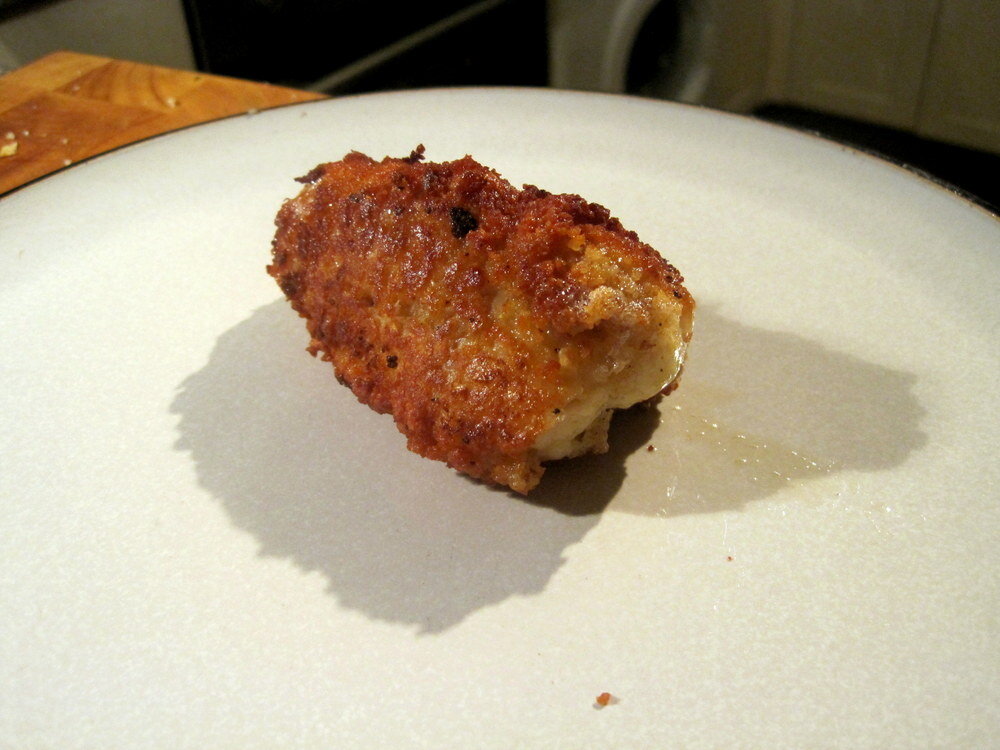 For the potato croquette, by contrast, I have expectations set by British institutional cuisine in the 1990s. That wet grey afternoon is the apogee of delight for the cook-from-frozen "croquet potatoes" that haunted boarding school plates and run-down function rooms. Piped mash with a chemical tang huddled under something unsettling and orange that claims breadcrumbs in its ancestry - no, historically they are not good.Like so many British food disasters (see: bread) our grounding experience of potato croquettes feels like a psychological accident born of walking around for too long with a nagging sense of sour cultural defeat and the industrial revolution in our back pockets. Step outside the contrived factory processes and look across the channel, and we'd see how it's done in minutes.They should be fluffy, savoury, and rather than some kind of buffet-sized battering ram, should be only just firmer than their béchamel cousins. They can take fillings, too, if you handle them carefully. In hindsight, that's fractionally harder than it sounds, but by no means insuperable.
For the potato croquette, by contrast, I have expectations set by British institutional cuisine in the 1990s. That wet grey afternoon is the apogee of delight for the cook-from-frozen "croquet potatoes" that haunted boarding school plates and run-down function rooms. Piped mash with a chemical tang huddled under something unsettling and orange that claims breadcrumbs in its ancestry - no, historically they are not good.Like so many British food disasters (see: bread) our grounding experience of potato croquettes feels like a psychological accident born of walking around for too long with a nagging sense of sour cultural defeat and the industrial revolution in our back pockets. Step outside the contrived factory processes and look across the channel, and we'd see how it's done in minutes.They should be fluffy, savoury, and rather than some kind of buffet-sized battering ram, should be only just firmer than their béchamel cousins. They can take fillings, too, if you handle them carefully. In hindsight, that's fractionally harder than it sounds, but by no means insuperable.
Ham Croquetas
I was going to do my research, honest. But Felicity Cloake is awesome, and has done it for me. So the croquetas I made were more or less her Perfect ham croquetas recipeI made a couple of mistakes, simplifications, and substitutions, so here's a whistle stop:
Ingredients:
Felicity Cloake uses better ingredients, basically, and I hadn't had time to shop properly. Also, I forgot to buy a leek.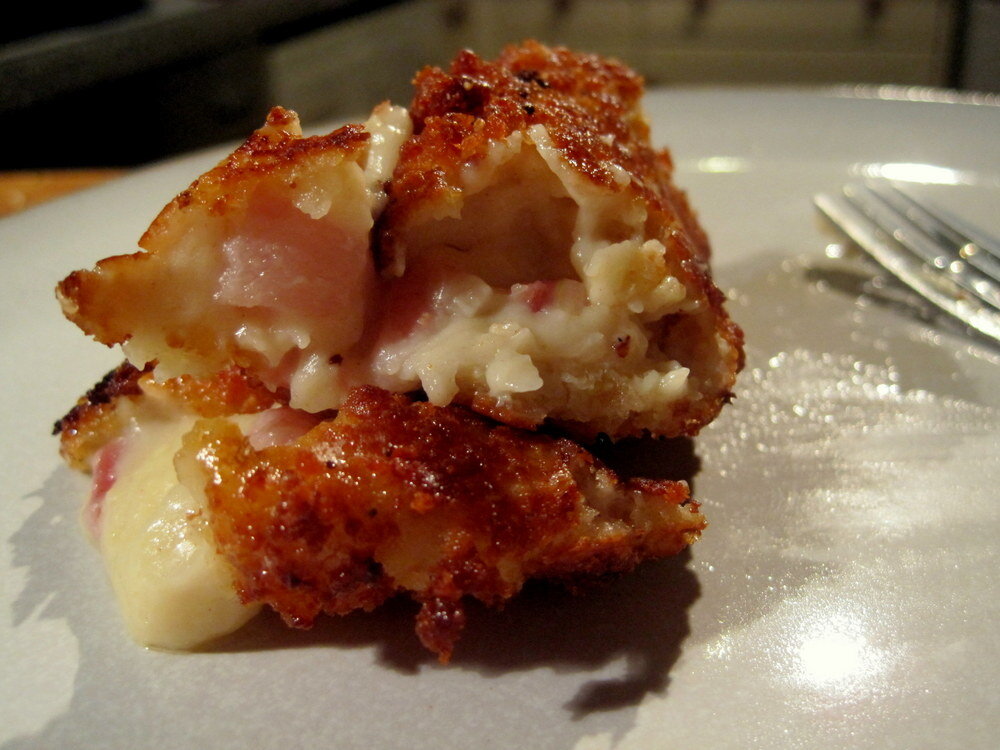
- Pancetta cubes
- A small onion
- Butter
- Flour
- Milk
- Breadcrumbs
- Parmesan
- A couple of eggs
Instructions:
Dice the onion very fine, and the pancetta likewise. Melt the butter and start the onion frying - soften it but don't colour it. Towards the end of the cooking time, add the pancetta cubes, and cook them off.From here you're just making thick béchamel. Stirr in the flour and gently cook it through on a low heat. Again, watch for colouring. Let it cook out gently for a few minutes, stopping it burning. The sauce needs to be really thick. Cloake's recipe uses 60g of flour to 500ml of milk. I did mine by eye, but I'd reckon it was similar, with perhaps a little less milk.Add the milk to the flour paste slowly, working it in until smooth, and giving it plenty of time for any chalkiness to cook out. Once you've got a thick, stiff white sauce, you're nearly done.I was short on time, so I cheated with cooling and stood the saucepan in a bowl of very cold water for about half an hour, stirring now and then. This seemed to get it down to a workable temperature for the next part.Grate parmesan into the breadcrumbs. Beat the eggs, and have a bowl of each close to hand. Flour your hands well - this gets really, really sticky. Shape big spoonsfuls of the sauce into fat little sausages between your hands. If it's cold enough, it should be pretty workable. It sticks a bit, and the flour on your hands gets wetter and harder to work with the more you do, so I found myself washing and restarting quite a bit. But once they're shaped, dip them in eggs, then breadcrumbs, and fry them: In hindsight, the frying should be deep frying. I shallow fried these in plenty of oil, which required ticklish, delicate handling of the croquetas when turning, but did work. Unfortunately, on auto-pilot for such things, I then put them in the oven for a few minutes "to finish". Do not do this. They collapsed.To their credit, they didn't collapse totally, and were salvageable. But between the faff of turning them in the pan and the fragile structure, you should totally deep-fry the buggers.
In hindsight, the frying should be deep frying. I shallow fried these in plenty of oil, which required ticklish, delicate handling of the croquetas when turning, but did work. Unfortunately, on auto-pilot for such things, I then put them in the oven for a few minutes "to finish". Do not do this. They collapsed.To their credit, they didn't collapse totally, and were salvageable. But between the faff of turning them in the pan and the fragile structure, you should totally deep-fry the buggers.
Potato and sauerkraut croquettes
The main research I did here was to flick through Practical Cookery, that great tome of 1980s identikit bistro tutelage, and sigh. A quick Google was more fruitful, yielding a Nigel Slater croquettes recipe, and another in the Independent by Mark Hix.There are obviously different schools of thought about how to treat the potatoes, and the rest is broadly convergent. Still carrying battle scars from a minor gnocchi disaster, I opted to bake them.
Ingredients:
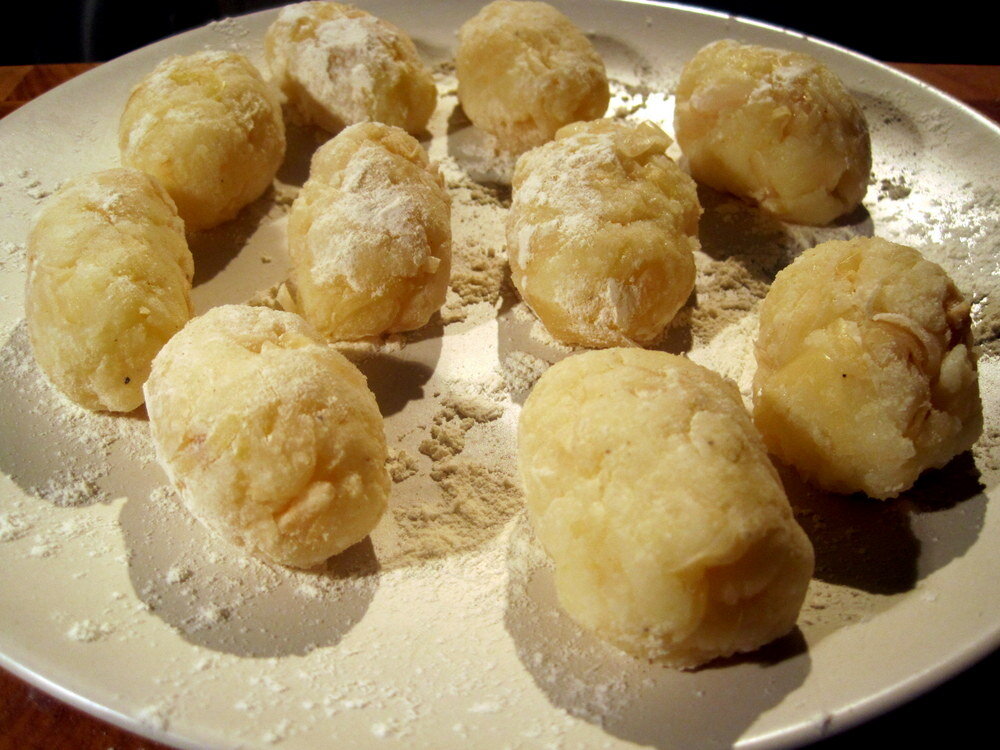 This is delightfully simple. The devil is absolutely in the preparation detail.
This is delightfully simple. The devil is absolutely in the preparation detail.
- A few large potatoes
- Sauerkraut
- Egg and breadcrumbs, as above
Instructions:
Bake the potatoes for an hour or so, or until firm on the outside. I was actually really short of time, so I kick-started them in the microwave for 10 minutes, and finished them in the oven for what was probably just under half an hour. don't do this if you can avoid it - you get a less homogeneous texture.Halve them when they're done and let them cool. Then scoop out the innards and gently mash them together with sauerkraut. This is actually the tricky bit. Mash them too much, and you work out the gluten. They'll become doughy and gluey and unappetising. Mash them too little and you risk lumps, and even friability. Oh, and they don't want to be too wet, or they'll be too pasty to handle (hence the baking and the halving before cooling).I scooped them out and put them through a ricer, then stirred in the sauerkraut. Mistake. The ricer alone may have over-worked them, but combining the filling had them heading into gnocchi territory. On balance, I'd have just done it all together with a spoon. Or made them unfilled with a standard masher.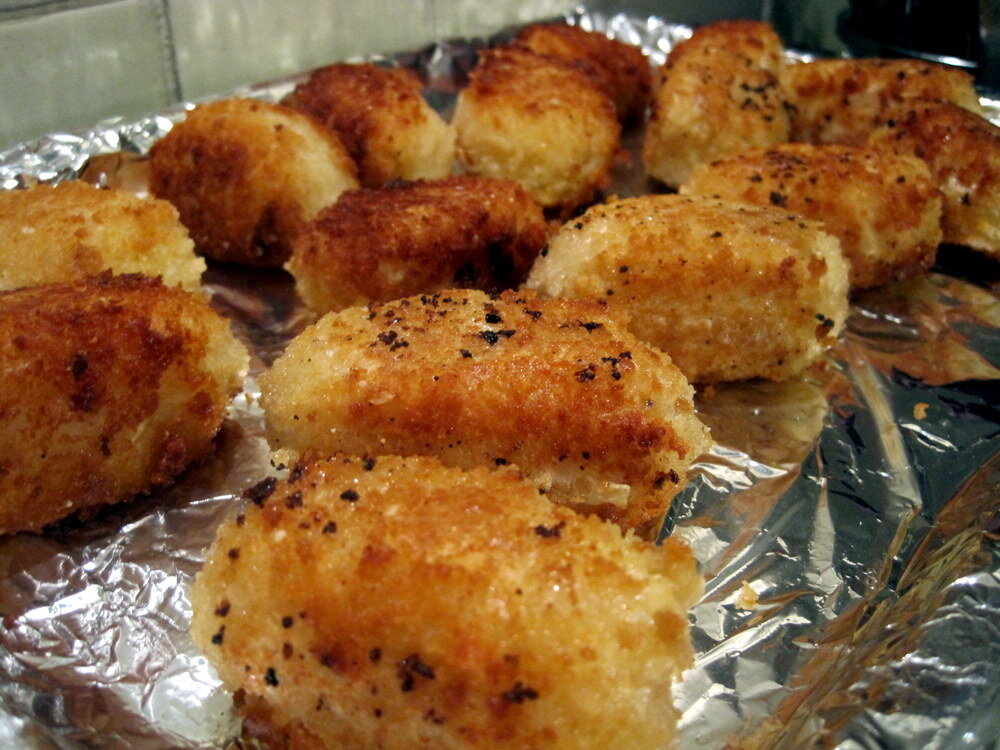 Shape them as above with the croquetas - carefully with well-floured hands. They're no less sticky and truculent.The frying is likewise the same. However, the croquettes take to shallow frying far more kindly, and will keep warm with no particularly ill consequences.I served both dishes with a apologetic side salad of dressed fine beans.The croquetas were the star of the show - salty, piggy, luxurious in texture. The way they ooze and fall apart when you put a fork through them is a joy. They would have really benefited from the Iberico ham of the Cloake recipe, however. Nonetheless, they are bloody delicious.
Shape them as above with the croquetas - carefully with well-floured hands. They're no less sticky and truculent.The frying is likewise the same. However, the croquettes take to shallow frying far more kindly, and will keep warm with no particularly ill consequences.I served both dishes with a apologetic side salad of dressed fine beans.The croquetas were the star of the show - salty, piggy, luxurious in texture. The way they ooze and fall apart when you put a fork through them is a joy. They would have really benefited from the Iberico ham of the Cloake recipe, however. Nonetheless, they are bloody delicious.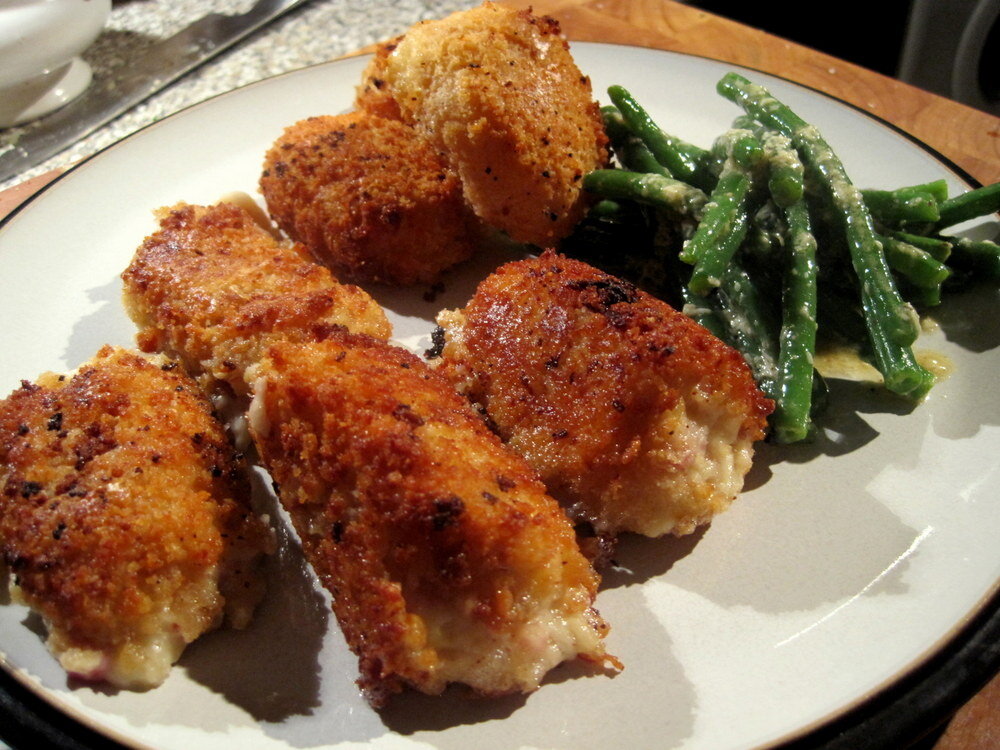 The croquettes were a little less auspicious in texture, but the flavour smacks it out of the park. The acidity of the sauerkraut cuts right through any potential stodginess and lifts the whole thing a bit. The crunch of it, too, is a pleasant surprise. All the fried starch could easily be overwhelming without something to set it off and the pickled flavours and bite do this brilliantly.
The croquettes were a little less auspicious in texture, but the flavour smacks it out of the park. The acidity of the sauerkraut cuts right through any potential stodginess and lifts the whole thing a bit. The crunch of it, too, is a pleasant surprise. All the fried starch could easily be overwhelming without something to set it off and the pickled flavours and bite do this brilliantly.